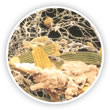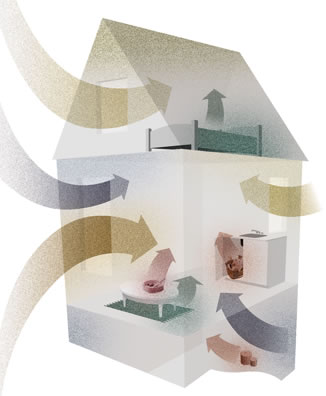Epurair - MA-1 HEPA Filtration System
The Solution For
Dusty Air!
 It is widely acknowledged that the air in our homes is filled with dust, pollen, mold and thousands of other pollutants. Whether it's a matter of particulates, gases or bio-burden, all these substances can provoke allergies, asthma and a variety of respiratory problems as well as disease. In fact, the air in most homes has a higher concentration of harmful particles than the air outdoors. Since we spend nearly 90% of our lives indoors, an indoor pollutant particle is 1,000 times more likely to reach our lungs than a pollutant released outdoors. It has been proven that poor indoor air quality is a major contributor to the increasing number of asthma and allergy cases every year. For the first time, researchers have concluded that smog can cause asthma. It is not surprising then, that nearly one out of ten children suffers from asthma (and allergies) and that three out of ten adults suffer from various respiratory conditions.
It is widely acknowledged that the air in our homes is filled with dust, pollen, mold and thousands of other pollutants. Whether it's a matter of particulates, gases or bio-burden, all these substances can provoke allergies, asthma and a variety of respiratory problems as well as disease. In fact, the air in most homes has a higher concentration of harmful particles than the air outdoors. Since we spend nearly 90% of our lives indoors, an indoor pollutant particle is 1,000 times more likely to reach our lungs than a pollutant released outdoors. It has been proven that poor indoor air quality is a major contributor to the increasing number of asthma and allergy cases every year. For the first time, researchers have concluded that smog can cause asthma. It is not surprising then, that nearly one out of ten children suffers from asthma (and allergies) and that three out of ten adults suffer from various respiratory conditions.
It has been proven that poor indoor air quality is a major contributor to the increasing number of asthma and allergy cases every year.
We breathe in millions of microscopic particles. Microns are the unit of choice to describe particle size. One micron is one thousandth of a millimetre. Particles less than 2.5 microns are more so potentially dangerous because they are able to penetrate the body’s natural defences and pass through into the lungs. The smaller the particle the more harmful it becomes for you and especially your children.
 Pollen
Pollen
Pollen comes from trees in the spring, flowers and plants in the summer and ragweed at the end of the summer. It is carried by the wind. Pollen enters our homes via cracks, open doors and windows.
 Dust Mites
Dust Mites
Mites and their feces reside in the dust present in our homes, especially in carpeting, cushions, bed coverings and stuffed toys. They are mainly responsible for a large number of allergic reactions (rhinitis, conjunctivitis, eczema, asthma…).
 Mold
Mold
The heat and humidity in a home foster their proliferation. Thousands of airborne mold spores are therefore found in homes.
 Cigarette Smoke
Cigarette Smoke
Each cigarette produces millions of microscopic dust particles, noxious gases and odours that travel into every room in your home.
 Chemical Substances
Chemical Substances
Numerous chemical substances are present in today's homes such as resins, glues, varnish, solvents, paint, household cleaning materials, formaldehyde, and other volatile organic compounds known as VOCs.
 SMOG
SMOG
Visible during hot summer days, smog is a brownish-yellow vapour containing ozone and particulates. Ozone is a highly oxidizing compound that can provoke asthma attacks and heart attacks.
The Solution For
Asthma and Allergies

One out of four people is allergic to at least one of these contaminants as well as others commonly found in our homes. Even though you may not suffer from any allergies, it would be wise for you to take into account the long-term effects of living in polluted surroundings.
In order to control asthma and allergies, physicians recommend decreasing our exposure to all allergens.
We are unable to decrease the quantity of pollutants outside our home. We can, however, help eliminate these allergens from the home and prevent many from entering.
Purifying the air we breathe in our homes is essential since we spend the major part of our lives indoors. Air pollution will trigger asthma, cause congestion in the nose and throat and irritate eyes, but recent research has discovered the added threat of increased risk of cardiovascular disease. Numerous health problems can develop as a result of continuous exposure to contaminants and allergens.
Some of the symptoms are

- Redness Of The Eyes
- Nasal Congestion
- Runny Nose
- Sneezing
- Coughing
- Shortness Of Breath
- Wheezing
- Redness Of The Skin
Recognized by Physicians
HEPA air purification systems is designed and recommended by respiratory physicians.
